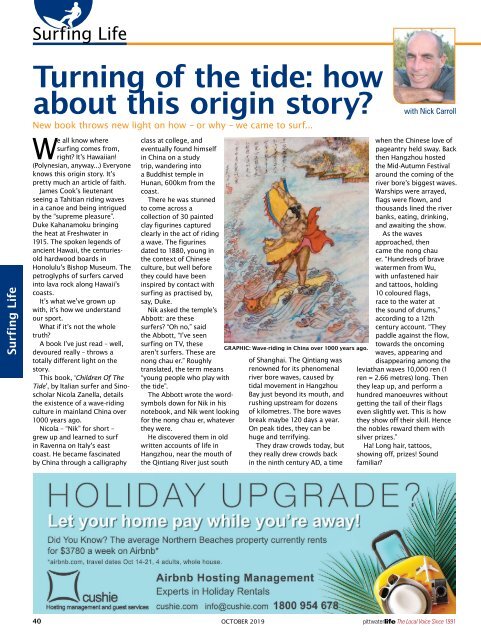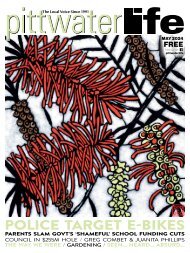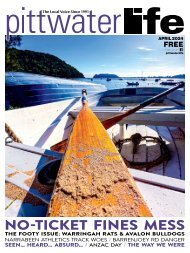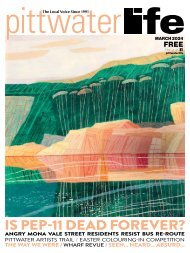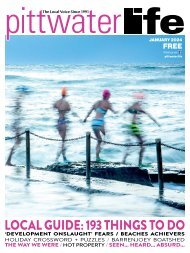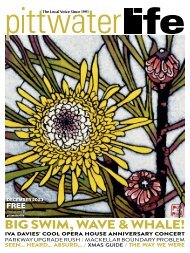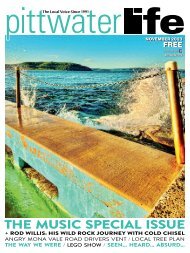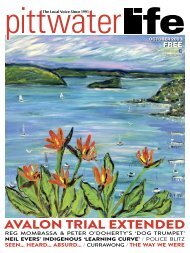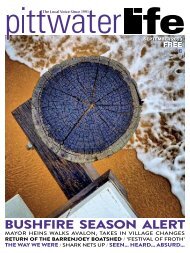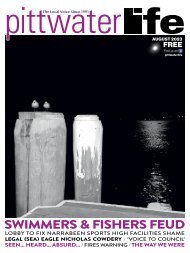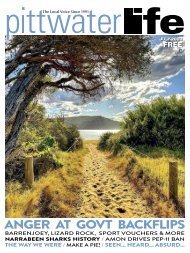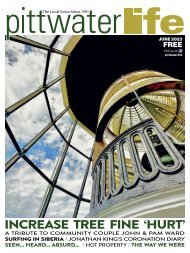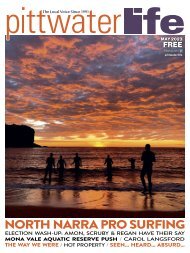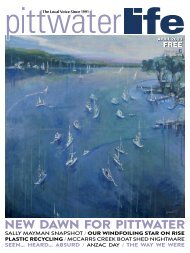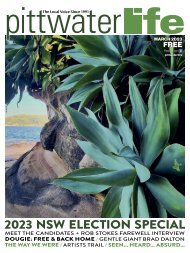Pittwater Life October 2019 Issue
Mental Health Month in Focus. Too Cute! - We Meet Newport's Celebrity Alpaca Capudo. SLSNSW Athlete of the Year. Barry Eaton's Life Between Lives. Plus: Get Ready for Boating Season.
Mental Health Month in Focus. Too Cute! - We Meet Newport's Celebrity Alpaca Capudo. SLSNSW Athlete of the Year. Barry Eaton's Life Between Lives. Plus: Get Ready for Boating Season.
You also want an ePaper? Increase the reach of your titles
YUMPU automatically turns print PDFs into web optimized ePapers that Google loves.
Surfing <strong>Life</strong><br />
Surfing <strong>Life</strong><br />
Turning of the tide: how<br />
about this origin story?<br />
New book throws new light on how – or why – we came to surf...<br />
We all know where<br />
surfing comes from,<br />
right? It’s Hawaiian!<br />
(Polynesian, anyway...) Everyone<br />
knows this origin story. It’s<br />
pretty much an article of faith.<br />
James Cook’s lieutenant<br />
seeing a Tahitian riding waves<br />
in a canoe and being intrigued<br />
by the “supreme pleasure”.<br />
Duke Kahanamoku bringing<br />
the heat at Freshwater in<br />
1915. The spoken legends of<br />
ancient Hawaii, the centuriesold<br />
hardwood boards in<br />
Honolulu’s Bishop Museum. The<br />
petroglyphs of surfers carved<br />
into lava rock along Hawaii’s<br />
coasts.<br />
It’s what we’ve grown up<br />
with, it’s how we understand<br />
our sport.<br />
What if it’s not the whole<br />
truth?<br />
A book I’ve just read – well,<br />
devoured really – throws a<br />
totally different light on the<br />
story.<br />
This book, ‘Children Of The<br />
Tide’, by Italian surfer and Sinoscholar<br />
Nicola Zanella, details<br />
the existence of a wave-riding<br />
culture in mainland China over<br />
1000 years ago.<br />
Nicola – “Nik” for short –<br />
grew up and learned to surf<br />
in Ravenna on Italy’s east<br />
coast. He became fascinated<br />
by China through a calligraphy<br />
class at college, and<br />
eventually found himself<br />
in China on a study<br />
trip, wandering into<br />
a Buddhist temple in<br />
Hunan, 600km from the<br />
coast.<br />
There he was stunned<br />
to come across a<br />
collection of 30 painted<br />
clay figurines captured<br />
clearly in the act of riding<br />
a wave. The figurines<br />
dated to 1880, young in<br />
the context of Chinese<br />
culture, but well before<br />
they could have been<br />
inspired by contact with<br />
surfing as practised by,<br />
say, Duke.<br />
Nik asked the temple’s<br />
Abbott: are these<br />
surfers? “Oh no,” said<br />
the Abbott, “I’ve seen<br />
surfing on TV, these<br />
aren’t surfers. These are<br />
nong chau er.” Roughly<br />
translated, the term means<br />
“young people who play with<br />
the tide”.<br />
The Abbott wrote the wordsymbols<br />
down for Nik in his<br />
notebook, and Nik went looking<br />
for the nong chau er, whatever<br />
they were.<br />
He discovered them in old<br />
written accounts of life in<br />
Hangzhou, near the mouth of<br />
the Qintiang River just south<br />
GRAPHIC: Wave-riding in China over 1000 years ago.<br />
of Shanghai. The Qintiang was<br />
renowned for its phenomenal<br />
river bore waves, caused by<br />
tidal movement in Hangzhou<br />
Bay just beyond its mouth, and<br />
rushing upstream for dozens<br />
of kilometres. The bore waves<br />
break maybe 120 days a year.<br />
On peak tides, they can be<br />
huge and terrifying.<br />
They draw crowds today, but<br />
they really drew crowds back<br />
in the ninth century AD, a time<br />
with Nick Carroll<br />
when the Chinese love of<br />
pageantry held sway. Back<br />
then Hangzhou hosted<br />
the Mid-Autumn Festival<br />
around the coming of the<br />
river bore’s biggest waves.<br />
Warships were arrayed,<br />
flags were flown, and<br />
thousands lined the river<br />
banks, eating, drinking,<br />
and awaiting the show.<br />
As the waves<br />
approached, then<br />
came the nong chau<br />
er. “Hundreds of brave<br />
watermen from Wu,<br />
with unfastened hair<br />
and tattoos, holding<br />
10 coloured flags,<br />
race to the water at<br />
the sound of drums,”<br />
according to a 12th<br />
century account. “They<br />
paddle against the flow,<br />
towards the oncoming<br />
waves, appearing and<br />
disappearing among the<br />
leviathan waves 10,000 ren (1<br />
ren = 2.66 metres) long. Then<br />
they leap up, and perform a<br />
hundred manoeuvres without<br />
getting the tail of their flags<br />
even slightly wet. This is how<br />
they show off their skill. Hence<br />
the nobles reward them with<br />
silver prizes.”<br />
Ha! Long hair, tattoos,<br />
showing off, prizes! Sound<br />
familiar?<br />
40 OCTOBER <strong>2019</strong><br />
The Local Voice Since 1991


